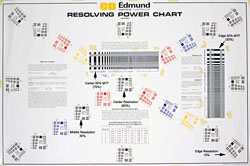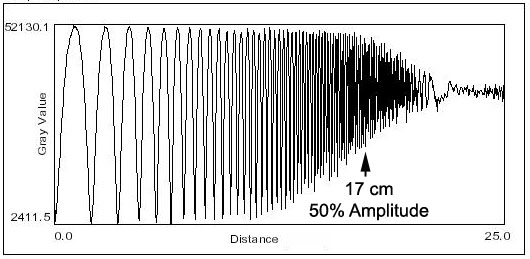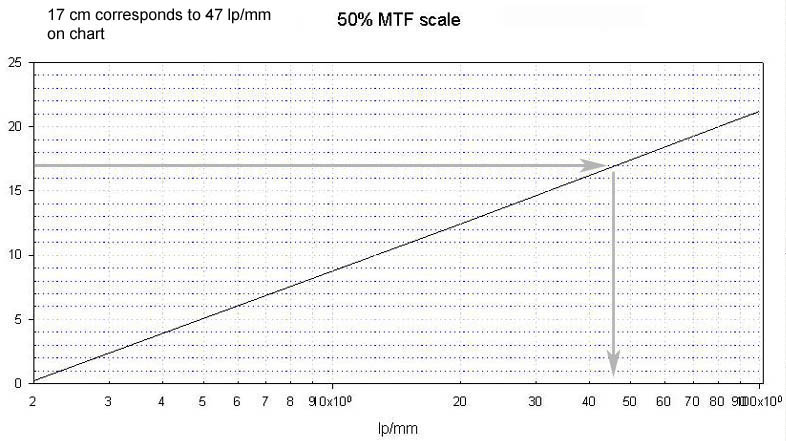Methods for Measuring Resolution
and 50% MTF
Resolution
Resolution
tests were run with the EOS-40D, EOS 20D and EOS 400D Digital Rebel XTi
with an EF 50mm f/1.4 lens at 88 inches working distance that allowed the
target to be fully viewed in the image field.
An Edmund Scientific lens
resolution chart with several overlain Koren 2003 lens test charts at
different angles was illuminated with two tungsten modeling bulbs
from monolight flashes. The lenses and camera were mounted on a Bogen
3033/Arca Swiss B1 tripod/head combination with a large Kirk bean bag
weighing down the tripod/head to dampen vibration. Three exposures using
aperture priority exposure and +1.3 exposure compensation were taken at
each aperture via cable shutter release at ISO 100 in RAW mode. The
central autofocus point was centered over the center pattern for each
exposure. The lens was defocused, and then refocused using autofocus for
each exposure. RAW files were converted to 300 dpi 16-bit tifs with Canon
Digital Photo Professional v 3.1 software, and images were analyzed in
Photoshop. Measurements were made from the sharpest image of the three
taken.
Measurement were made at the center pattern, a middle pattern, and the
edge pattern as shown here.
Both line patterns at 90° angles had to be clearly visible. The
highest resolution score for each aperture in the best of two photos taken
at each aperture was recorded to minimize the the effect of potential
autofocus error. Center-weighted resolution was calculated (60% center;
30% middle; 10% edge). Resolutions (lpm) at each f/stop were calculated
using the method on the chart as follows.
Image lines pairs per mm (image lpm or lp/mm) = lpm resolved on chart X
(D-fo) / fo) where fo = focal length of lens and D = Distance from the
chart to the middle of the lens.
50% MTF (modulation transfer
function):
There is general agreement that perceived image
sharpness is more closely related to the spatial frequency (lp/mm) where
MTF is 50% (i.e., where contrast has dropped by half) than to resolution
alone. I used the Koren 2003 lens test chart
developed
and explained by Norman Koren to calculate 50% MTF. Printed test
charts were placed on the Edmund Scientific Test Chart as in the middle
and edge of the chart as shown
here. The same photographs are used to measure resolution and 50%
MTF. Measures of 50% MTF were calculated using a centered weighted pattern
(70% center, 30% edge). Because 50% MTF was measured with 1.6 factor APS-C
cameras at greater working distance than would be used for full frame
cameras, the 50% MTF values can only be compared with values obtained with
other APS-C cameras or lenses tested with APS- cameras.
The
imaged sine patterns were analyzed with and measurements were made on the
resulting Plot Profile to determine line pair per mm frequency of 50%
contrast as explained in detail on the Norman Koren website.
Details of calculating 50% MTF:
1. The 5mm Koren 2003 lens test chart designed to be printed at 25 cm
long (50X magnification) was downloaded from the Koren website and printed
on semi-gloss paper with a Epson 1270 printer at 1440 dpi. Charts are
trimmed and mounted on the Edmund Scientific Test Chart as shown:

2.
The chart is photographed at a working distance that is close to 1/2 the
recommended distance so that the entire Edmund Scientific chart can be
photographed for resolution and determination of 50% MTF. The method was
developed for full frame EOS cameras and Canon lenses as explained here
for the EF 50mm f/1.2L.
50% MTF results from this test series should not be compared directly to
results with full frame lenses.
3. The 16-bit tif files are
opened in image analysis software to analyze the sine patterns on the
chart (top band). I used
ImageJ software, public domain software off the NIH site.

Click on "File" and then "Open" to select and open the
tif of interest. A 16-bit grey scale image will be displayed.
4.
Click on the "magnifying cursor symbol" to fill the window with
the Koren chart image and click on the "hand" icon to move the
chart image into the middle of the window.
5. Click on the line
icon and draw a straight line through the upper sine pattern bar on the
Koren chart.

6.
Click on the "Analyze" menu and select "set scale" and
enter "known distance" as "25" and "units"
as "cm".
7. Click on "Analyze" again and
select "Plot Profile."
8. A sine wave pattern will be
generated and displayed.

9.
The full amplitude of the sine wave on my computer screen has a 7 cm
sweep. I just take a rule and run it down the plot towards 25cm until the
amplitude is 50% (3.5 cm). In the example, 50% amplitude is at 17 cm on
the chart. This corresponds on a plot of cm of chart versus a log plot of
spatial frequency below to 47 lp/mm.





